Detailed Analysis of Business and the Business Environment at NatWest
VerifiedAdded on 2020/06/06
|12
|3286
|44
Report
AI Summary
This report provides a comprehensive analysis of the business environment, using NatWest as a case study. It begins with an introduction to the business environment and its impact on organizations. The report then delves into different types of business organizations, including private, public, and voluntary sectors, detailing their purpose, size, and scope. It further examines the key business functions and their link with organizational structure and objectives, with a focus on NatWest's organizational structure and its strategic objectives such as profitability, organizational development, cost minimization, and customer satisfaction. The report explores the functional, divisional, and matrix structures. It emphasizes the importance of setting clear, measurable goals and objectives for organizational success. The conclusion summarizes the key findings and the significance of understanding the business environment for organizational success. This report is a valuable resource for understanding business operations and strategies within a dynamic market.
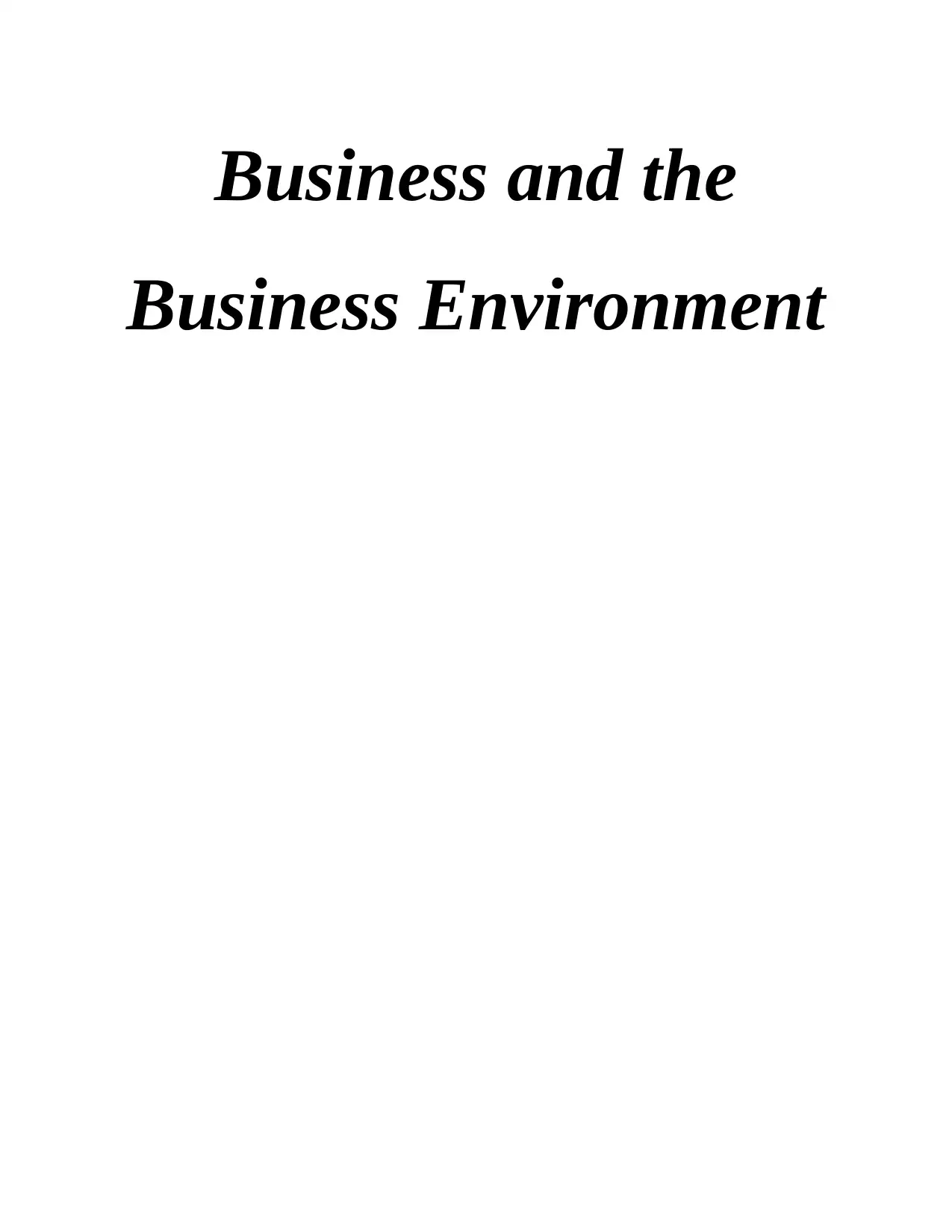
Business and the
Business Environment
Business Environment
Paraphrase This Document
Need a fresh take? Get an instant paraphrase of this document with our AI Paraphraser
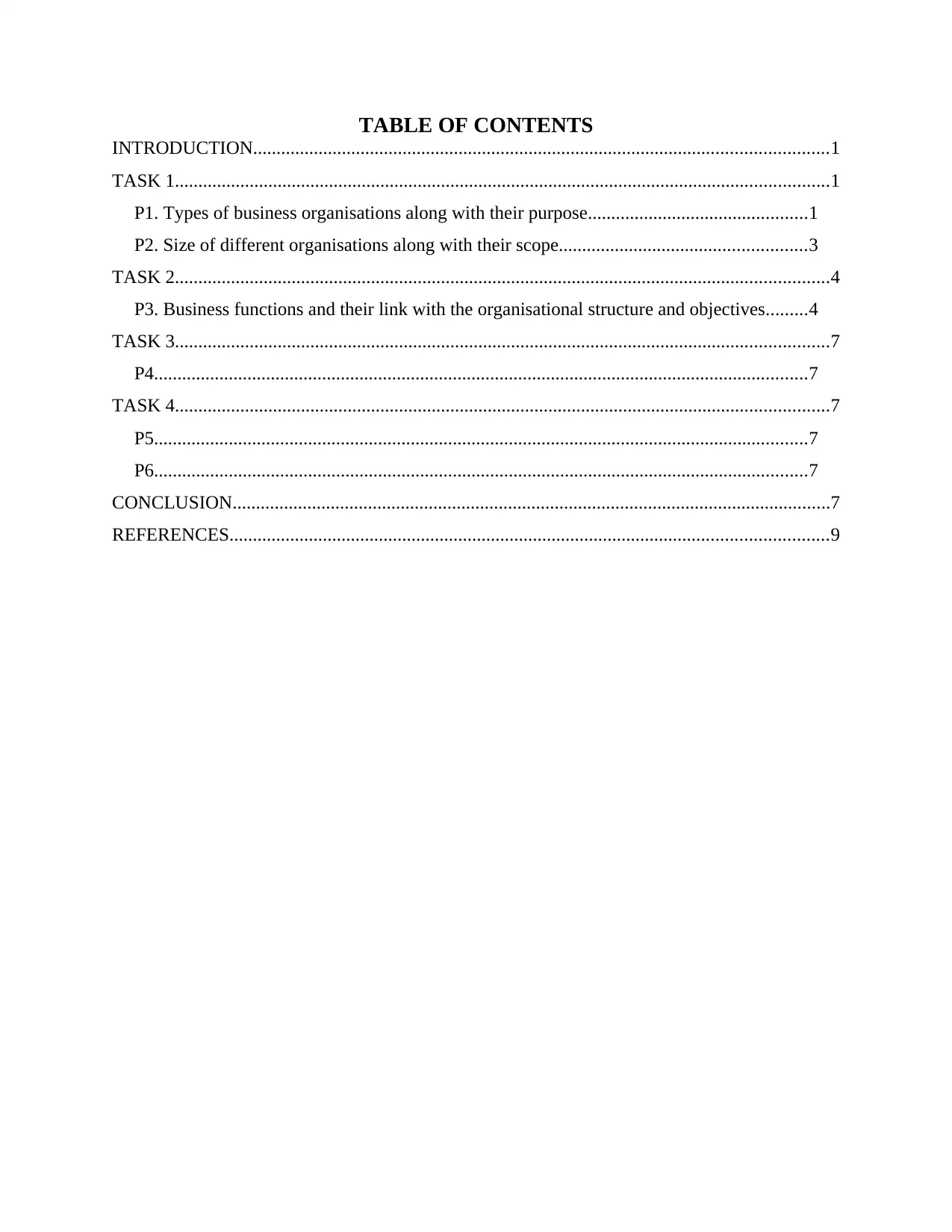
TABLE OF CONTENTS
INTRODUCTION...........................................................................................................................1
TASK 1............................................................................................................................................1
P1. Types of business organisations along with their purpose...............................................1
P2. Size of different organisations along with their scope.....................................................3
TASK 2............................................................................................................................................4
P3. Business functions and their link with the organisational structure and objectives.........4
TASK 3............................................................................................................................................7
P4............................................................................................................................................7
TASK 4............................................................................................................................................7
P5............................................................................................................................................7
P6............................................................................................................................................7
CONCLUSION................................................................................................................................7
REFERENCES................................................................................................................................9
INTRODUCTION...........................................................................................................................1
TASK 1............................................................................................................................................1
P1. Types of business organisations along with their purpose...............................................1
P2. Size of different organisations along with their scope.....................................................3
TASK 2............................................................................................................................................4
P3. Business functions and their link with the organisational structure and objectives.........4
TASK 3............................................................................................................................................7
P4............................................................................................................................................7
TASK 4............................................................................................................................................7
P5............................................................................................................................................7
P6............................................................................................................................................7
CONCLUSION................................................................................................................................7
REFERENCES................................................................................................................................9
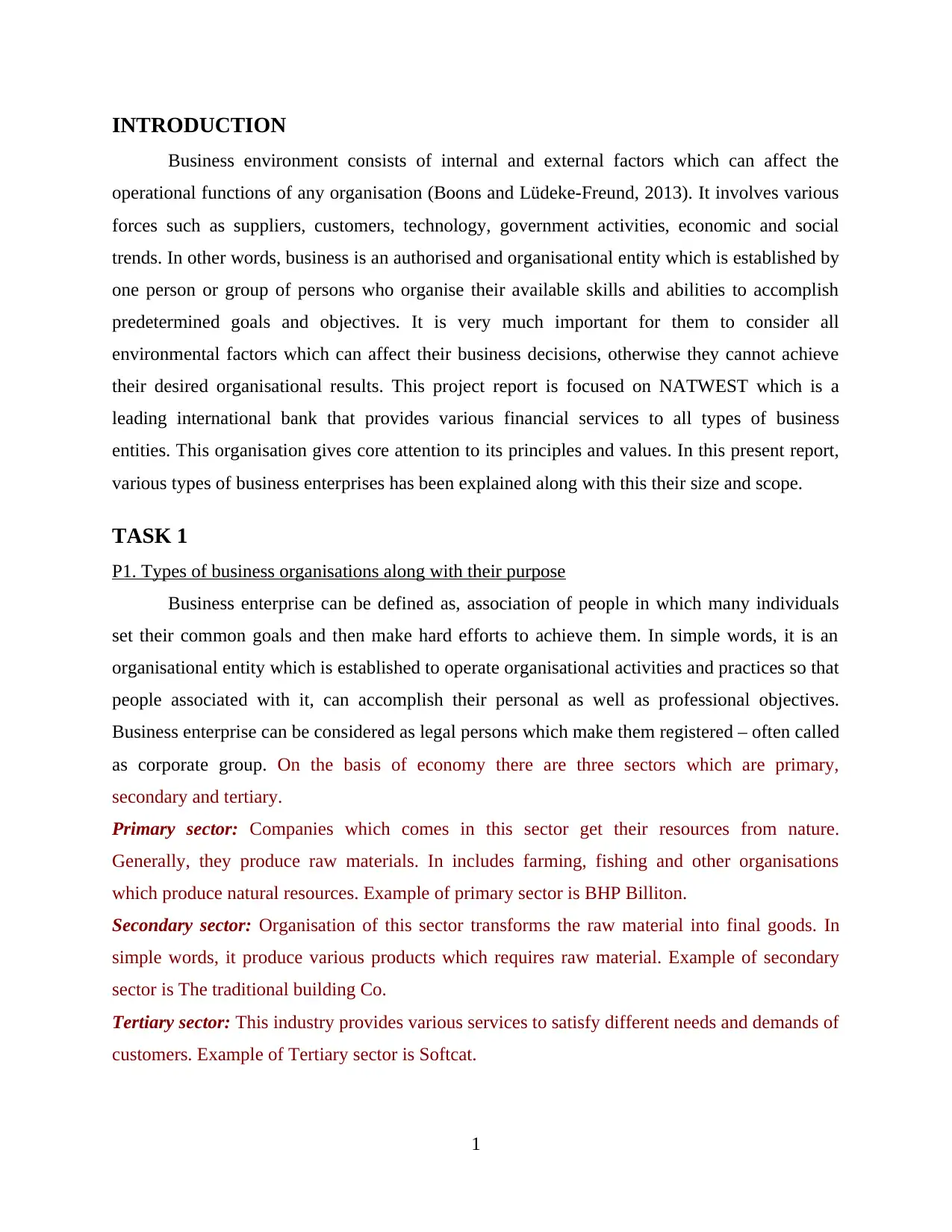
INTRODUCTION
Business environment consists of internal and external factors which can affect the
operational functions of any organisation (Boons and Lüdeke-Freund, 2013). It involves various
forces such as suppliers, customers, technology, government activities, economic and social
trends. In other words, business is an authorised and organisational entity which is established by
one person or group of persons who organise their available skills and abilities to accomplish
predetermined goals and objectives. It is very much important for them to consider all
environmental factors which can affect their business decisions, otherwise they cannot achieve
their desired organisational results. This project report is focused on NATWEST which is a
leading international bank that provides various financial services to all types of business
entities. This organisation gives core attention to its principles and values. In this present report,
various types of business enterprises has been explained along with this their size and scope.
TASK 1
P1. Types of business organisations along with their purpose
Business enterprise can be defined as, association of people in which many individuals
set their common goals and then make hard efforts to achieve them. In simple words, it is an
organisational entity which is established to operate organisational activities and practices so that
people associated with it, can accomplish their personal as well as professional objectives.
Business enterprise can be considered as legal persons which make them registered – often called
as corporate group. On the basis of economy there are three sectors which are primary,
secondary and tertiary.
Primary sector: Companies which comes in this sector get their resources from nature.
Generally, they produce raw materials. In includes farming, fishing and other organisations
which produce natural resources. Example of primary sector is BHP Billiton.
Secondary sector: Organisation of this sector transforms the raw material into final goods. In
simple words, it produce various products which requires raw material. Example of secondary
sector is The traditional building Co.
Tertiary sector: This industry provides various services to satisfy different needs and demands of
customers. Example of Tertiary sector is Softcat.
1
Business environment consists of internal and external factors which can affect the
operational functions of any organisation (Boons and Lüdeke-Freund, 2013). It involves various
forces such as suppliers, customers, technology, government activities, economic and social
trends. In other words, business is an authorised and organisational entity which is established by
one person or group of persons who organise their available skills and abilities to accomplish
predetermined goals and objectives. It is very much important for them to consider all
environmental factors which can affect their business decisions, otherwise they cannot achieve
their desired organisational results. This project report is focused on NATWEST which is a
leading international bank that provides various financial services to all types of business
entities. This organisation gives core attention to its principles and values. In this present report,
various types of business enterprises has been explained along with this their size and scope.
TASK 1
P1. Types of business organisations along with their purpose
Business enterprise can be defined as, association of people in which many individuals
set their common goals and then make hard efforts to achieve them. In simple words, it is an
organisational entity which is established to operate organisational activities and practices so that
people associated with it, can accomplish their personal as well as professional objectives.
Business enterprise can be considered as legal persons which make them registered – often called
as corporate group. On the basis of economy there are three sectors which are primary,
secondary and tertiary.
Primary sector: Companies which comes in this sector get their resources from nature.
Generally, they produce raw materials. In includes farming, fishing and other organisations
which produce natural resources. Example of primary sector is BHP Billiton.
Secondary sector: Organisation of this sector transforms the raw material into final goods. In
simple words, it produce various products which requires raw material. Example of secondary
sector is The traditional building Co.
Tertiary sector: This industry provides various services to satisfy different needs and demands of
customers. Example of Tertiary sector is Softcat.
1
⊘ This is a preview!⊘
Do you want full access?
Subscribe today to unlock all pages.

Trusted by 1+ million students worldwide
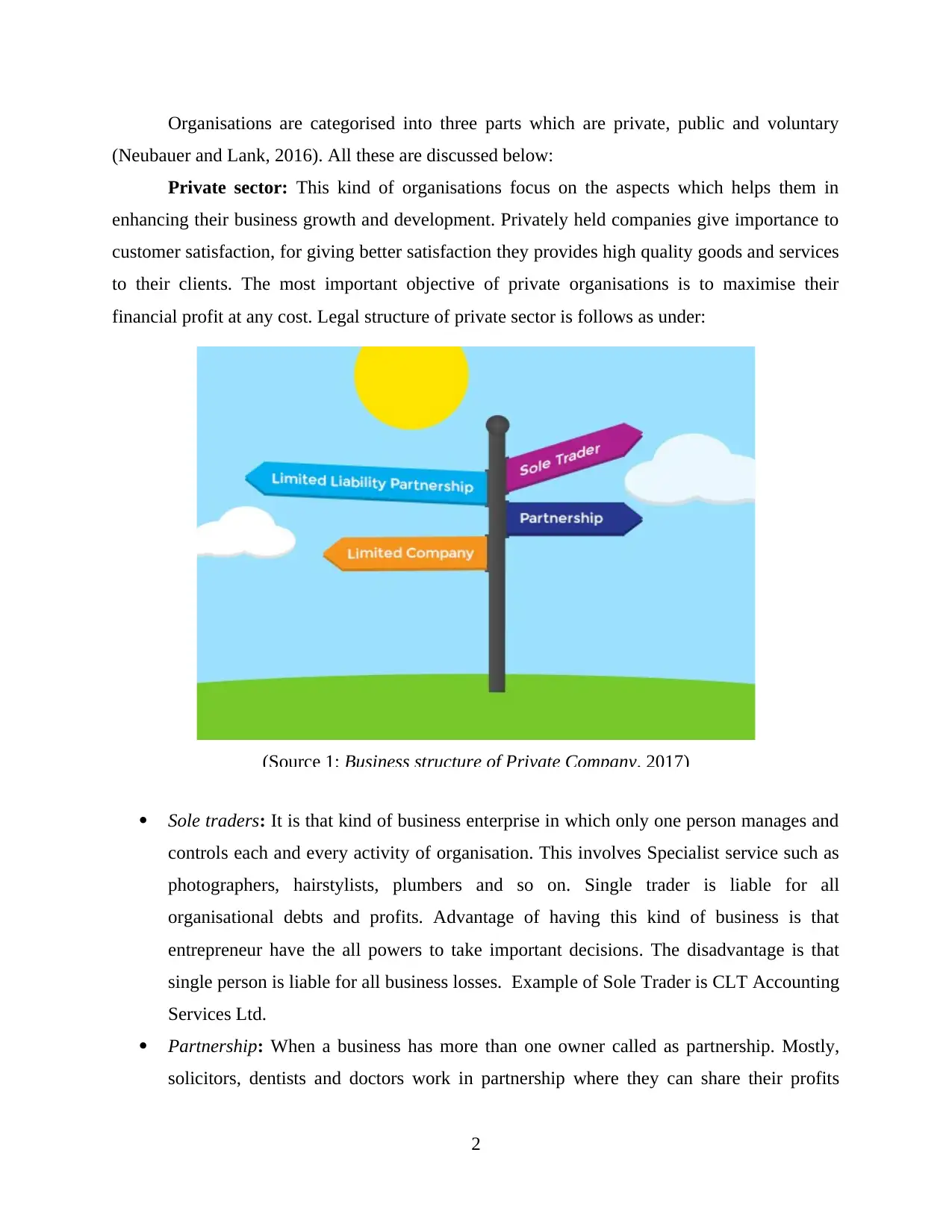
Organisations are categorised into three parts which are private, public and voluntary
(Neubauer and Lank, 2016). All these are discussed below:
Private sector: This kind of organisations focus on the aspects which helps them in
enhancing their business growth and development. Privately held companies give importance to
customer satisfaction, for giving better satisfaction they provides high quality goods and services
to their clients. The most important objective of private organisations is to maximise their
financial profit at any cost. Legal structure of private sector is follows as under:
Sole traders: It is that kind of business enterprise in which only one person manages and
controls each and every activity of organisation. This involves Specialist service such as
photographers, hairstylists, plumbers and so on. Single trader is liable for all
organisational debts and profits. Advantage of having this kind of business is that
entrepreneur have the all powers to take important decisions. The disadvantage is that
single person is liable for all business losses. Example of Sole Trader is CLT Accounting
Services Ltd.
Partnership: When a business has more than one owner called as partnership. Mostly,
solicitors, dentists and doctors work in partnership where they can share their profits
2
(Source 1: Business structure of Private Company, 2017)
(Neubauer and Lank, 2016). All these are discussed below:
Private sector: This kind of organisations focus on the aspects which helps them in
enhancing their business growth and development. Privately held companies give importance to
customer satisfaction, for giving better satisfaction they provides high quality goods and services
to their clients. The most important objective of private organisations is to maximise their
financial profit at any cost. Legal structure of private sector is follows as under:
Sole traders: It is that kind of business enterprise in which only one person manages and
controls each and every activity of organisation. This involves Specialist service such as
photographers, hairstylists, plumbers and so on. Single trader is liable for all
organisational debts and profits. Advantage of having this kind of business is that
entrepreneur have the all powers to take important decisions. The disadvantage is that
single person is liable for all business losses. Example of Sole Trader is CLT Accounting
Services Ltd.
Partnership: When a business has more than one owner called as partnership. Mostly,
solicitors, dentists and doctors work in partnership where they can share their profits
2
(Source 1: Business structure of Private Company, 2017)
Paraphrase This Document
Need a fresh take? Get an instant paraphrase of this document with our AI Paraphraser
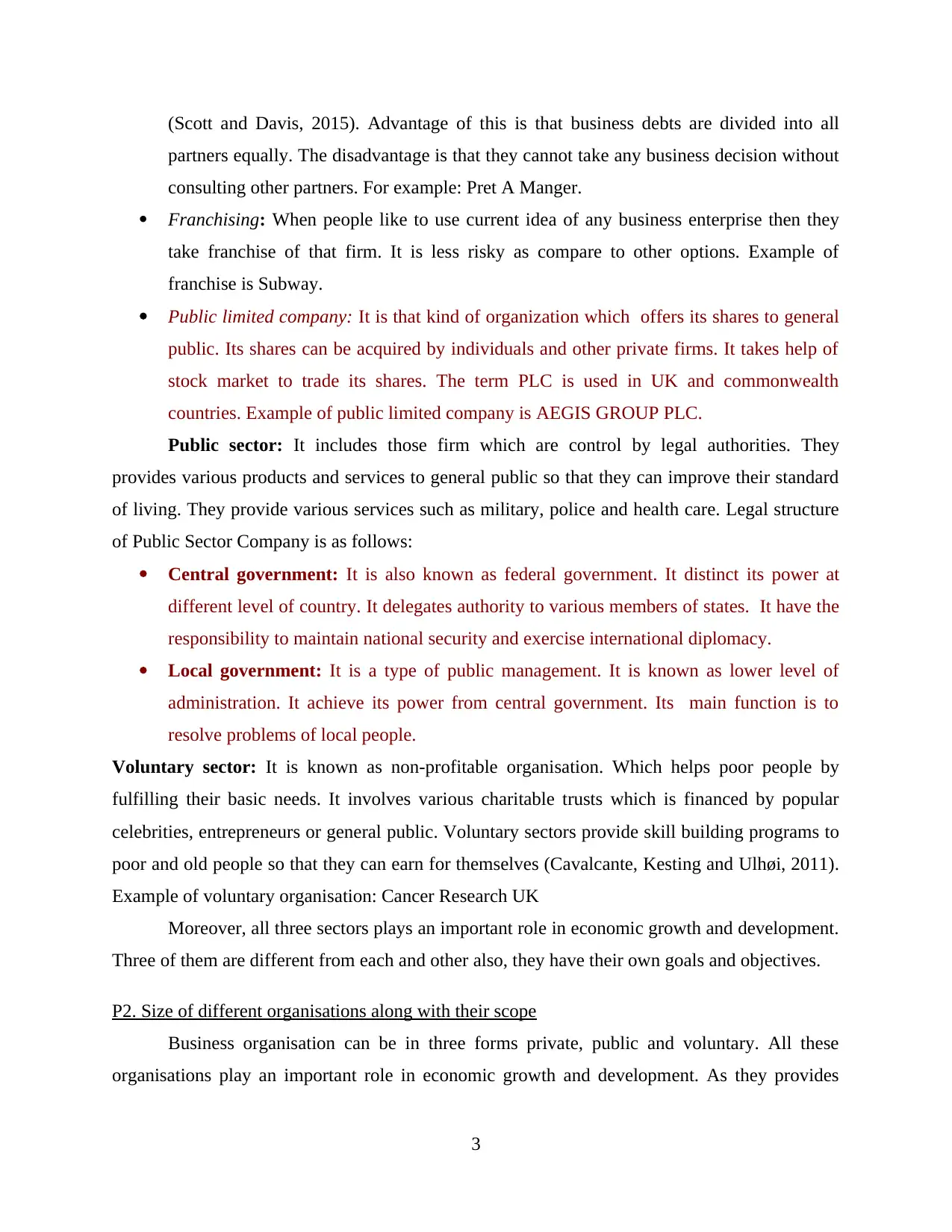
(Scott and Davis, 2015). Advantage of this is that business debts are divided into all
partners equally. The disadvantage is that they cannot take any business decision without
consulting other partners. For example: Pret A Manger.
Franchising: When people like to use current idea of any business enterprise then they
take franchise of that firm. It is less risky as compare to other options. Example of
franchise is Subway.
Public limited company: It is that kind of organization which offers its shares to general
public. Its shares can be acquired by individuals and other private firms. It takes help of
stock market to trade its shares. The term PLC is used in UK and commonwealth
countries. Example of public limited company is AEGIS GROUP PLC.
Public sector: It includes those firm which are control by legal authorities. They
provides various products and services to general public so that they can improve their standard
of living. They provide various services such as military, police and health care. Legal structure
of Public Sector Company is as follows:
Central government: It is also known as federal government. It distinct its power at
different level of country. It delegates authority to various members of states. It have the
responsibility to maintain national security and exercise international diplomacy.
Local government: It is a type of public management. It is known as lower level of
administration. It achieve its power from central government. Its main function is to
resolve problems of local people.
Voluntary sector: It is known as non-profitable organisation. Which helps poor people by
fulfilling their basic needs. It involves various charitable trusts which is financed by popular
celebrities, entrepreneurs or general public. Voluntary sectors provide skill building programs to
poor and old people so that they can earn for themselves (Cavalcante, Kesting and Ulhøi, 2011).
Example of voluntary organisation: Cancer Research UK
Moreover, all three sectors plays an important role in economic growth and development.
Three of them are different from each and other also, they have their own goals and objectives.
P2. Size of different organisations along with their scope
Business organisation can be in three forms private, public and voluntary. All these
organisations play an important role in economic growth and development. As they provides
3
partners equally. The disadvantage is that they cannot take any business decision without
consulting other partners. For example: Pret A Manger.
Franchising: When people like to use current idea of any business enterprise then they
take franchise of that firm. It is less risky as compare to other options. Example of
franchise is Subway.
Public limited company: It is that kind of organization which offers its shares to general
public. Its shares can be acquired by individuals and other private firms. It takes help of
stock market to trade its shares. The term PLC is used in UK and commonwealth
countries. Example of public limited company is AEGIS GROUP PLC.
Public sector: It includes those firm which are control by legal authorities. They
provides various products and services to general public so that they can improve their standard
of living. They provide various services such as military, police and health care. Legal structure
of Public Sector Company is as follows:
Central government: It is also known as federal government. It distinct its power at
different level of country. It delegates authority to various members of states. It have the
responsibility to maintain national security and exercise international diplomacy.
Local government: It is a type of public management. It is known as lower level of
administration. It achieve its power from central government. Its main function is to
resolve problems of local people.
Voluntary sector: It is known as non-profitable organisation. Which helps poor people by
fulfilling their basic needs. It involves various charitable trusts which is financed by popular
celebrities, entrepreneurs or general public. Voluntary sectors provide skill building programs to
poor and old people so that they can earn for themselves (Cavalcante, Kesting and Ulhøi, 2011).
Example of voluntary organisation: Cancer Research UK
Moreover, all three sectors plays an important role in economic growth and development.
Three of them are different from each and other also, they have their own goals and objectives.
P2. Size of different organisations along with their scope
Business organisation can be in three forms private, public and voluntary. All these
organisations play an important role in economic growth and development. As they provides
3
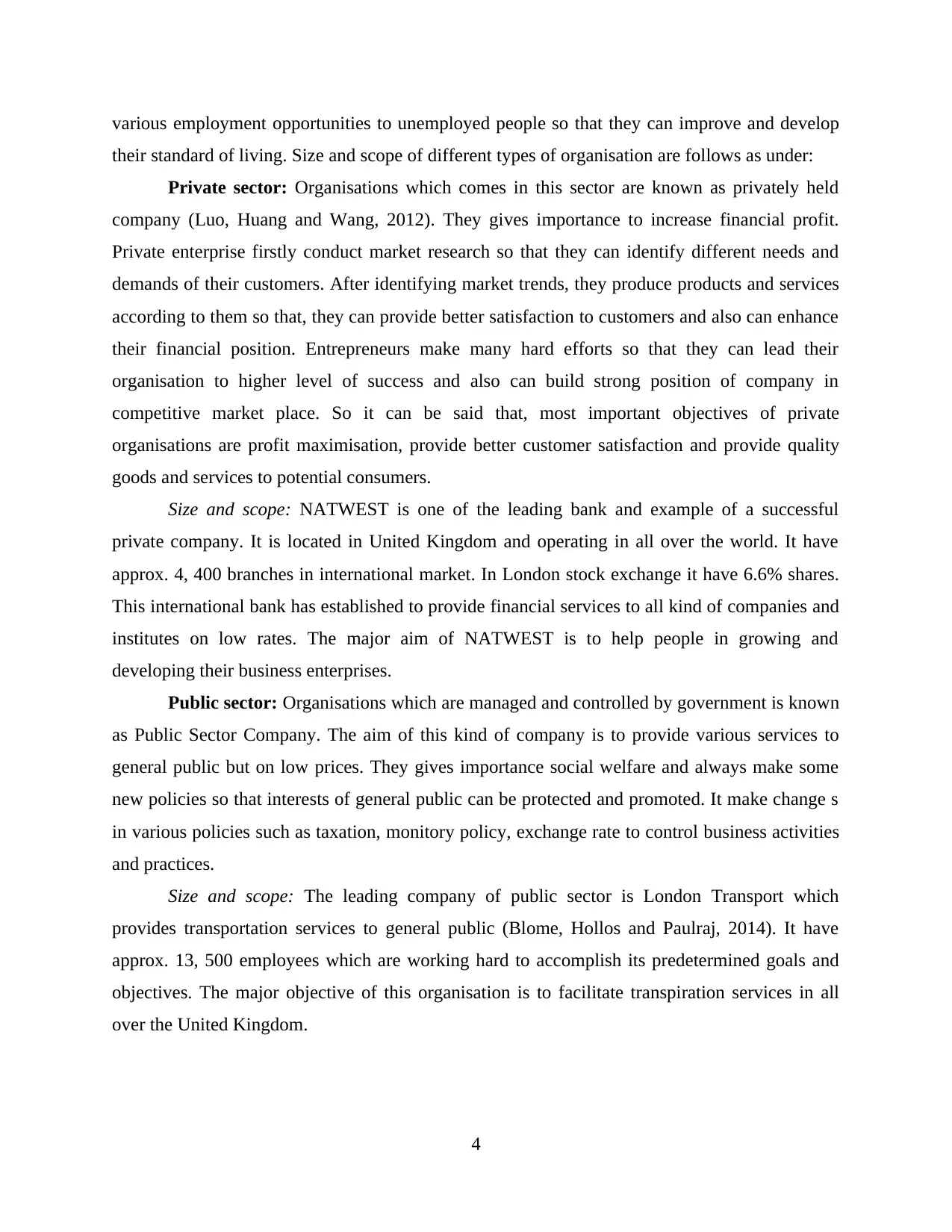
various employment opportunities to unemployed people so that they can improve and develop
their standard of living. Size and scope of different types of organisation are follows as under:
Private sector: Organisations which comes in this sector are known as privately held
company (Luo, Huang and Wang, 2012). They gives importance to increase financial profit.
Private enterprise firstly conduct market research so that they can identify different needs and
demands of their customers. After identifying market trends, they produce products and services
according to them so that, they can provide better satisfaction to customers and also can enhance
their financial position. Entrepreneurs make many hard efforts so that they can lead their
organisation to higher level of success and also can build strong position of company in
competitive market place. So it can be said that, most important objectives of private
organisations are profit maximisation, provide better customer satisfaction and provide quality
goods and services to potential consumers.
Size and scope: NATWEST is one of the leading bank and example of a successful
private company. It is located in United Kingdom and operating in all over the world. It have
approx. 4, 400 branches in international market. In London stock exchange it have 6.6% shares.
This international bank has established to provide financial services to all kind of companies and
institutes on low rates. The major aim of NATWEST is to help people in growing and
developing their business enterprises.
Public sector: Organisations which are managed and controlled by government is known
as Public Sector Company. The aim of this kind of company is to provide various services to
general public but on low prices. They gives importance social welfare and always make some
new policies so that interests of general public can be protected and promoted. It make change s
in various policies such as taxation, monitory policy, exchange rate to control business activities
and practices.
Size and scope: The leading company of public sector is London Transport which
provides transportation services to general public (Blome, Hollos and Paulraj, 2014). It have
approx. 13, 500 employees which are working hard to accomplish its predetermined goals and
objectives. The major objective of this organisation is to facilitate transpiration services in all
over the United Kingdom.
4
their standard of living. Size and scope of different types of organisation are follows as under:
Private sector: Organisations which comes in this sector are known as privately held
company (Luo, Huang and Wang, 2012). They gives importance to increase financial profit.
Private enterprise firstly conduct market research so that they can identify different needs and
demands of their customers. After identifying market trends, they produce products and services
according to them so that, they can provide better satisfaction to customers and also can enhance
their financial position. Entrepreneurs make many hard efforts so that they can lead their
organisation to higher level of success and also can build strong position of company in
competitive market place. So it can be said that, most important objectives of private
organisations are profit maximisation, provide better customer satisfaction and provide quality
goods and services to potential consumers.
Size and scope: NATWEST is one of the leading bank and example of a successful
private company. It is located in United Kingdom and operating in all over the world. It have
approx. 4, 400 branches in international market. In London stock exchange it have 6.6% shares.
This international bank has established to provide financial services to all kind of companies and
institutes on low rates. The major aim of NATWEST is to help people in growing and
developing their business enterprises.
Public sector: Organisations which are managed and controlled by government is known
as Public Sector Company. The aim of this kind of company is to provide various services to
general public but on low prices. They gives importance social welfare and always make some
new policies so that interests of general public can be protected and promoted. It make change s
in various policies such as taxation, monitory policy, exchange rate to control business activities
and practices.
Size and scope: The leading company of public sector is London Transport which
provides transportation services to general public (Blome, Hollos and Paulraj, 2014). It have
approx. 13, 500 employees which are working hard to accomplish its predetermined goals and
objectives. The major objective of this organisation is to facilitate transpiration services in all
over the United Kingdom.
4
⊘ This is a preview!⊘
Do you want full access?
Subscribe today to unlock all pages.

Trusted by 1+ million students worldwide
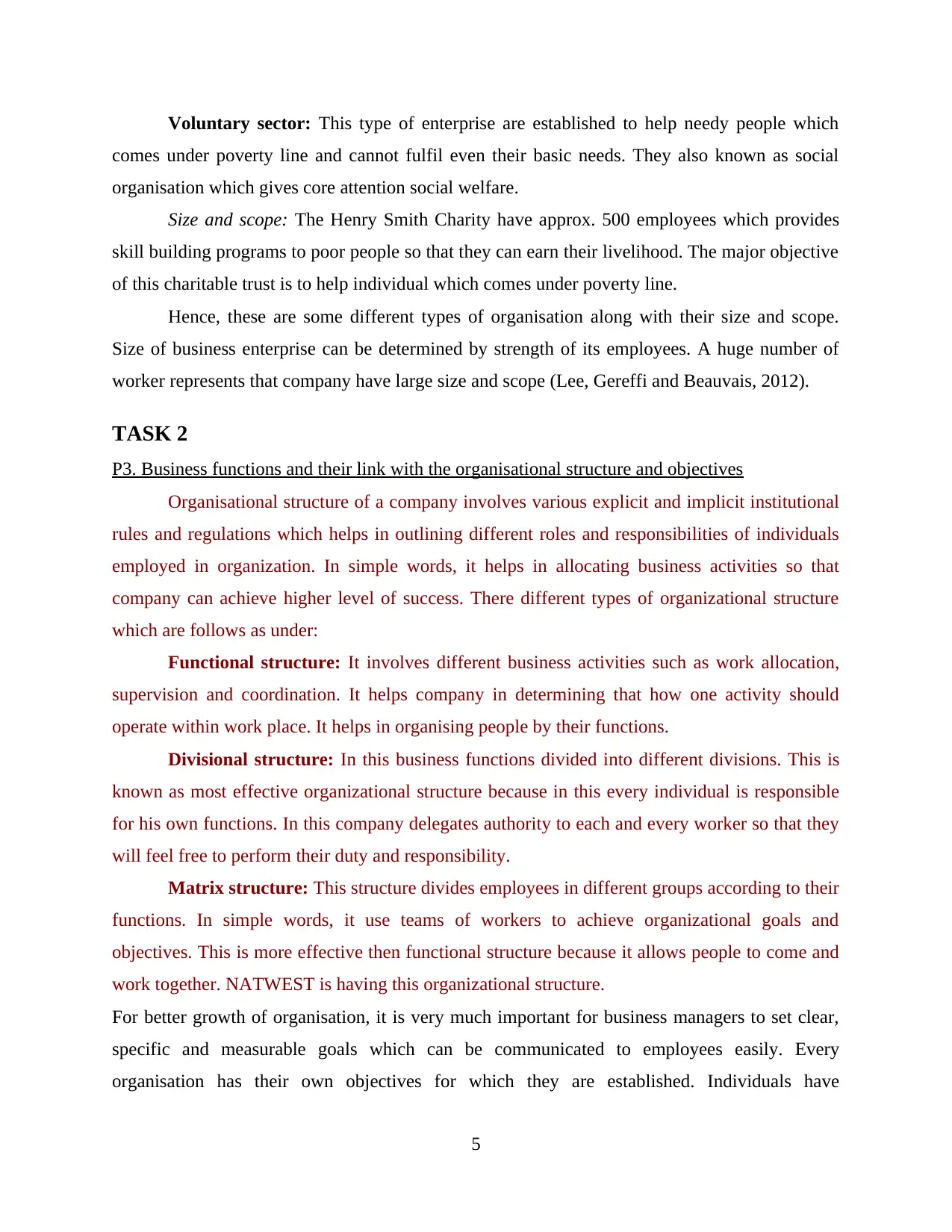
Voluntary sector: This type of enterprise are established to help needy people which
comes under poverty line and cannot fulfil even their basic needs. They also known as social
organisation which gives core attention social welfare.
Size and scope: The Henry Smith Charity have approx. 500 employees which provides
skill building programs to poor people so that they can earn their livelihood. The major objective
of this charitable trust is to help individual which comes under poverty line.
Hence, these are some different types of organisation along with their size and scope.
Size of business enterprise can be determined by strength of its employees. A huge number of
worker represents that company have large size and scope (Lee, Gereffi and Beauvais, 2012).
TASK 2
P3. Business functions and their link with the organisational structure and objectives
Organisational structure of a company involves various explicit and implicit institutional
rules and regulations which helps in outlining different roles and responsibilities of individuals
employed in organization. In simple words, it helps in allocating business activities so that
company can achieve higher level of success. There different types of organizational structure
which are follows as under:
Functional structure: It involves different business activities such as work allocation,
supervision and coordination. It helps company in determining that how one activity should
operate within work place. It helps in organising people by their functions.
Divisional structure: In this business functions divided into different divisions. This is
known as most effective organizational structure because in this every individual is responsible
for his own functions. In this company delegates authority to each and every worker so that they
will feel free to perform their duty and responsibility.
Matrix structure: This structure divides employees in different groups according to their
functions. In simple words, it use teams of workers to achieve organizational goals and
objectives. This is more effective then functional structure because it allows people to come and
work together. NATWEST is having this organizational structure.
For better growth of organisation, it is very much important for business managers to set clear,
specific and measurable goals which can be communicated to employees easily. Every
organisation has their own objectives for which they are established. Individuals have
5
comes under poverty line and cannot fulfil even their basic needs. They also known as social
organisation which gives core attention social welfare.
Size and scope: The Henry Smith Charity have approx. 500 employees which provides
skill building programs to poor people so that they can earn their livelihood. The major objective
of this charitable trust is to help individual which comes under poverty line.
Hence, these are some different types of organisation along with their size and scope.
Size of business enterprise can be determined by strength of its employees. A huge number of
worker represents that company have large size and scope (Lee, Gereffi and Beauvais, 2012).
TASK 2
P3. Business functions and their link with the organisational structure and objectives
Organisational structure of a company involves various explicit and implicit institutional
rules and regulations which helps in outlining different roles and responsibilities of individuals
employed in organization. In simple words, it helps in allocating business activities so that
company can achieve higher level of success. There different types of organizational structure
which are follows as under:
Functional structure: It involves different business activities such as work allocation,
supervision and coordination. It helps company in determining that how one activity should
operate within work place. It helps in organising people by their functions.
Divisional structure: In this business functions divided into different divisions. This is
known as most effective organizational structure because in this every individual is responsible
for his own functions. In this company delegates authority to each and every worker so that they
will feel free to perform their duty and responsibility.
Matrix structure: This structure divides employees in different groups according to their
functions. In simple words, it use teams of workers to achieve organizational goals and
objectives. This is more effective then functional structure because it allows people to come and
work together. NATWEST is having this organizational structure.
For better growth of organisation, it is very much important for business managers to set clear,
specific and measurable goals which can be communicated to employees easily. Every
organisation has their own objectives for which they are established. Individuals have
5
Paraphrase This Document
Need a fresh take? Get an instant paraphrase of this document with our AI Paraphraser
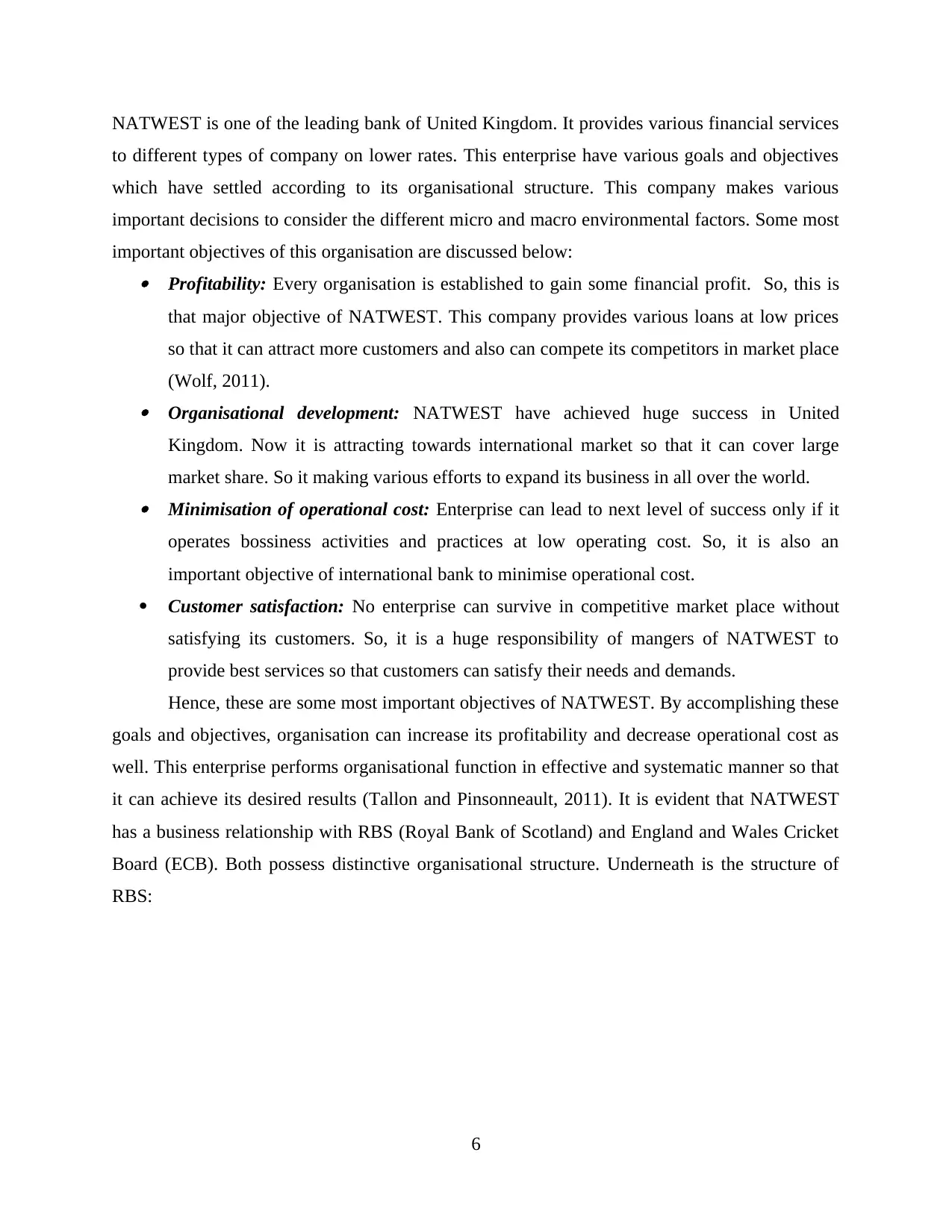
NATWEST is one of the leading bank of United Kingdom. It provides various financial services
to different types of company on lower rates. This enterprise have various goals and objectives
which have settled according to its organisational structure. This company makes various
important decisions to consider the different micro and macro environmental factors. Some most
important objectives of this organisation are discussed below: Profitability: Every organisation is established to gain some financial profit. So, this is
that major objective of NATWEST. This company provides various loans at low prices
so that it can attract more customers and also can compete its competitors in market place
(Wolf, 2011). Organisational development: NATWEST have achieved huge success in United
Kingdom. Now it is attracting towards international market so that it can cover large
market share. So it making various efforts to expand its business in all over the world. Minimisation of operational cost: Enterprise can lead to next level of success only if it
operates bossiness activities and practices at low operating cost. So, it is also an
important objective of international bank to minimise operational cost.
Customer satisfaction: No enterprise can survive in competitive market place without
satisfying its customers. So, it is a huge responsibility of mangers of NATWEST to
provide best services so that customers can satisfy their needs and demands.
Hence, these are some most important objectives of NATWEST. By accomplishing these
goals and objectives, organisation can increase its profitability and decrease operational cost as
well. This enterprise performs organisational function in effective and systematic manner so that
it can achieve its desired results (Tallon and Pinsonneault, 2011). It is evident that NATWEST
has a business relationship with RBS (Royal Bank of Scotland) and England and Wales Cricket
Board (ECB). Both possess distinctive organisational structure. Underneath is the structure of
RBS:
6
to different types of company on lower rates. This enterprise have various goals and objectives
which have settled according to its organisational structure. This company makes various
important decisions to consider the different micro and macro environmental factors. Some most
important objectives of this organisation are discussed below: Profitability: Every organisation is established to gain some financial profit. So, this is
that major objective of NATWEST. This company provides various loans at low prices
so that it can attract more customers and also can compete its competitors in market place
(Wolf, 2011). Organisational development: NATWEST have achieved huge success in United
Kingdom. Now it is attracting towards international market so that it can cover large
market share. So it making various efforts to expand its business in all over the world. Minimisation of operational cost: Enterprise can lead to next level of success only if it
operates bossiness activities and practices at low operating cost. So, it is also an
important objective of international bank to minimise operational cost.
Customer satisfaction: No enterprise can survive in competitive market place without
satisfying its customers. So, it is a huge responsibility of mangers of NATWEST to
provide best services so that customers can satisfy their needs and demands.
Hence, these are some most important objectives of NATWEST. By accomplishing these
goals and objectives, organisation can increase its profitability and decrease operational cost as
well. This enterprise performs organisational function in effective and systematic manner so that
it can achieve its desired results (Tallon and Pinsonneault, 2011). It is evident that NATWEST
has a business relationship with RBS (Royal Bank of Scotland) and England and Wales Cricket
Board (ECB). Both possess distinctive organisational structure. Underneath is the structure of
RBS:
6
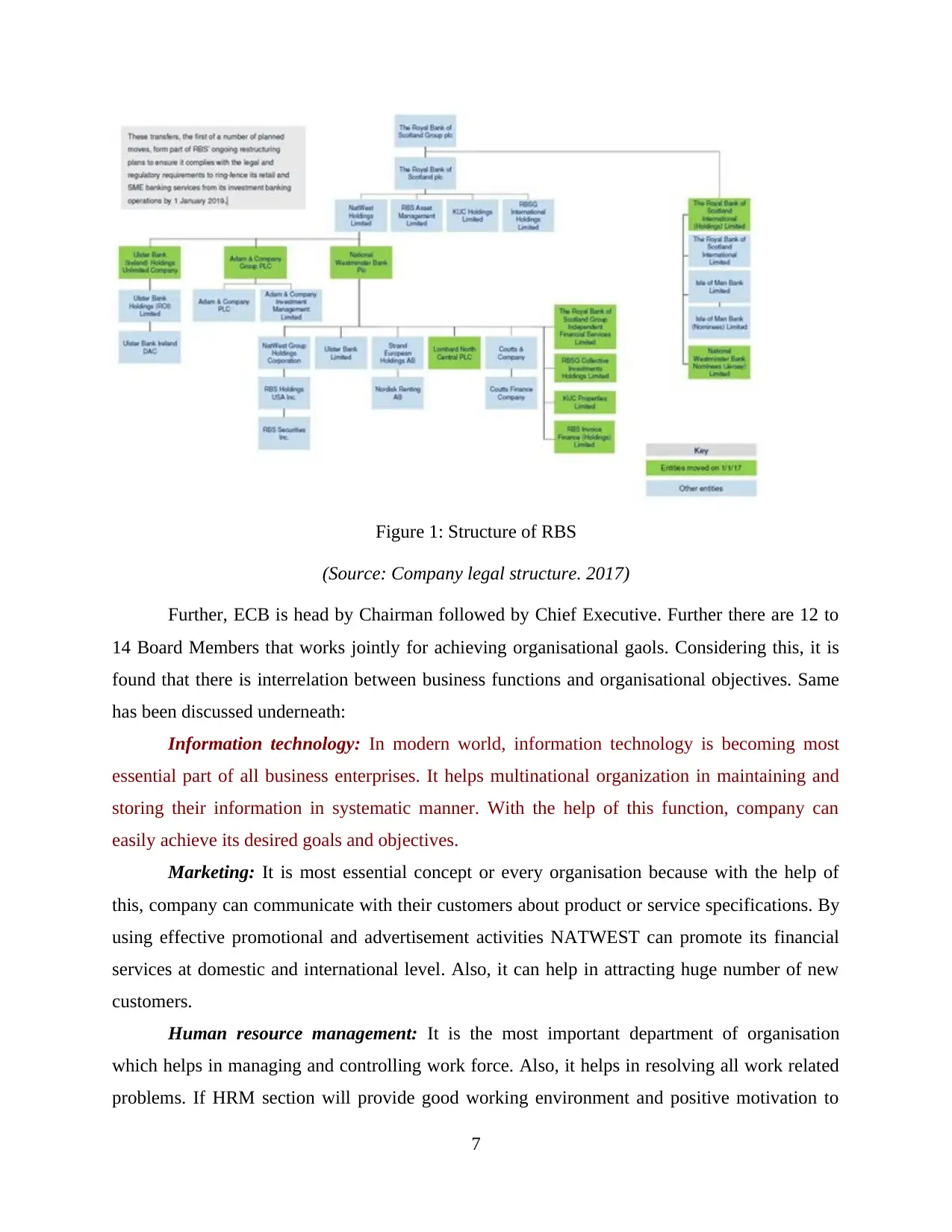
Figure 1: Structure of RBS
(Source: Company legal structure. 2017)
Further, ECB is head by Chairman followed by Chief Executive. Further there are 12 to
14 Board Members that works jointly for achieving organisational gaols. Considering this, it is
found that there is interrelation between business functions and organisational objectives. Same
has been discussed underneath:
Information technology: In modern world, information technology is becoming most
essential part of all business enterprises. It helps multinational organization in maintaining and
storing their information in systematic manner. With the help of this function, company can
easily achieve its desired goals and objectives.
Marketing: It is most essential concept or every organisation because with the help of
this, company can communicate with their customers about product or service specifications. By
using effective promotional and advertisement activities NATWEST can promote its financial
services at domestic and international level. Also, it can help in attracting huge number of new
customers.
Human resource management: It is the most important department of organisation
which helps in managing and controlling work force. Also, it helps in resolving all work related
problems. If HRM section will provide good working environment and positive motivation to
7
(Source: Company legal structure. 2017)
Further, ECB is head by Chairman followed by Chief Executive. Further there are 12 to
14 Board Members that works jointly for achieving organisational gaols. Considering this, it is
found that there is interrelation between business functions and organisational objectives. Same
has been discussed underneath:
Information technology: In modern world, information technology is becoming most
essential part of all business enterprises. It helps multinational organization in maintaining and
storing their information in systematic manner. With the help of this function, company can
easily achieve its desired goals and objectives.
Marketing: It is most essential concept or every organisation because with the help of
this, company can communicate with their customers about product or service specifications. By
using effective promotional and advertisement activities NATWEST can promote its financial
services at domestic and international level. Also, it can help in attracting huge number of new
customers.
Human resource management: It is the most important department of organisation
which helps in managing and controlling work force. Also, it helps in resolving all work related
problems. If HRM section will provide good working environment and positive motivation to
7
⊘ This is a preview!⊘
Do you want full access?
Subscribe today to unlock all pages.

Trusted by 1+ million students worldwide
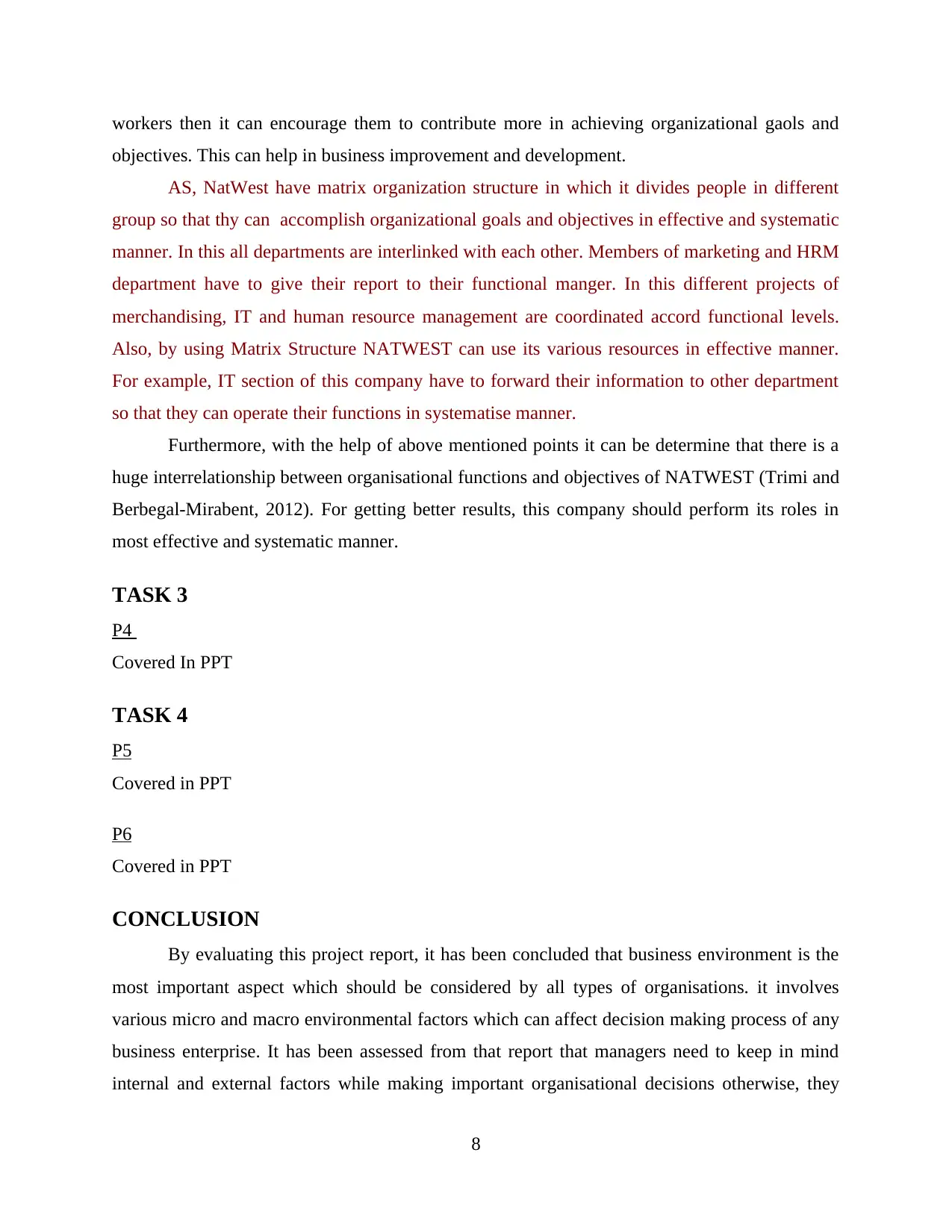
workers then it can encourage them to contribute more in achieving organizational gaols and
objectives. This can help in business improvement and development.
AS, NatWest have matrix organization structure in which it divides people in different
group so that thy can accomplish organizational goals and objectives in effective and systematic
manner. In this all departments are interlinked with each other. Members of marketing and HRM
department have to give their report to their functional manger. In this different projects of
merchandising, IT and human resource management are coordinated accord functional levels.
Also, by using Matrix Structure NATWEST can use its various resources in effective manner.
For example, IT section of this company have to forward their information to other department
so that they can operate their functions in systematise manner.
Furthermore, with the help of above mentioned points it can be determine that there is a
huge interrelationship between organisational functions and objectives of NATWEST (Trimi and
Berbegal-Mirabent, 2012). For getting better results, this company should perform its roles in
most effective and systematic manner.
TASK 3
P4
Covered In PPT
TASK 4
P5
Covered in PPT
P6
Covered in PPT
CONCLUSION
By evaluating this project report, it has been concluded that business environment is the
most important aspect which should be considered by all types of organisations. it involves
various micro and macro environmental factors which can affect decision making process of any
business enterprise. It has been assessed from that report that managers need to keep in mind
internal and external factors while making important organisational decisions otherwise, they
8
objectives. This can help in business improvement and development.
AS, NatWest have matrix organization structure in which it divides people in different
group so that thy can accomplish organizational goals and objectives in effective and systematic
manner. In this all departments are interlinked with each other. Members of marketing and HRM
department have to give their report to their functional manger. In this different projects of
merchandising, IT and human resource management are coordinated accord functional levels.
Also, by using Matrix Structure NATWEST can use its various resources in effective manner.
For example, IT section of this company have to forward their information to other department
so that they can operate their functions in systematise manner.
Furthermore, with the help of above mentioned points it can be determine that there is a
huge interrelationship between organisational functions and objectives of NATWEST (Trimi and
Berbegal-Mirabent, 2012). For getting better results, this company should perform its roles in
most effective and systematic manner.
TASK 3
P4
Covered In PPT
TASK 4
P5
Covered in PPT
P6
Covered in PPT
CONCLUSION
By evaluating this project report, it has been concluded that business environment is the
most important aspect which should be considered by all types of organisations. it involves
various micro and macro environmental factors which can affect decision making process of any
business enterprise. It has been assessed from that report that managers need to keep in mind
internal and external factors while making important organisational decisions otherwise, they
8
Paraphrase This Document
Need a fresh take? Get an instant paraphrase of this document with our AI Paraphraser

cannot lead their business to higher level of success. Report has evaluated that there are three
types of organisations namely private, public and voluntary which can be taken into account by
the international bank for financial services.
9
types of organisations namely private, public and voluntary which can be taken into account by
the international bank for financial services.
9
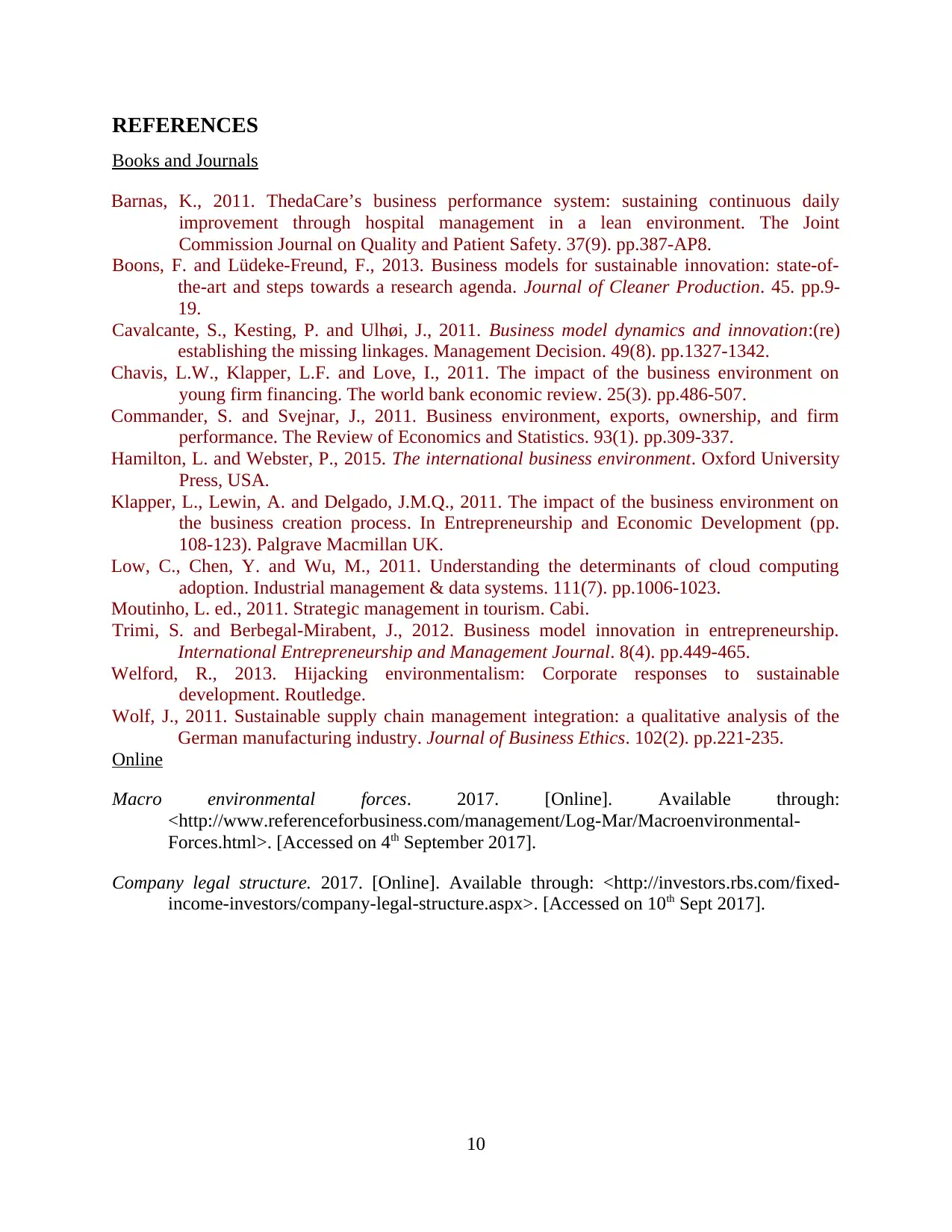
REFERENCES
Books and Journals
Barnas, K., 2011. ThedaCare’s business performance system: sustaining continuous daily
improvement through hospital management in a lean environment. The Joint
Commission Journal on Quality and Patient Safety. 37(9). pp.387-AP8.
Boons, F. and Lüdeke-Freund, F., 2013. Business models for sustainable innovation: state-of-
the-art and steps towards a research agenda. Journal of Cleaner Production. 45. pp.9-
19.
Cavalcante, S., Kesting, P. and Ulhøi, J., 2011. Business model dynamics and innovation:(re)
establishing the missing linkages. Management Decision. 49(8). pp.1327-1342.
Chavis, L.W., Klapper, L.F. and Love, I., 2011. The impact of the business environment on
young firm financing. The world bank economic review. 25(3). pp.486-507.
Commander, S. and Svejnar, J., 2011. Business environment, exports, ownership, and firm
performance. The Review of Economics and Statistics. 93(1). pp.309-337.
Hamilton, L. and Webster, P., 2015. The international business environment. Oxford University
Press, USA.
Klapper, L., Lewin, A. and Delgado, J.M.Q., 2011. The impact of the business environment on
the business creation process. In Entrepreneurship and Economic Development (pp.
108-123). Palgrave Macmillan UK.
Low, C., Chen, Y. and Wu, M., 2011. Understanding the determinants of cloud computing
adoption. Industrial management & data systems. 111(7). pp.1006-1023.
Moutinho, L. ed., 2011. Strategic management in tourism. Cabi.
Trimi, S. and Berbegal-Mirabent, J., 2012. Business model innovation in entrepreneurship.
International Entrepreneurship and Management Journal. 8(4). pp.449-465.
Welford, R., 2013. Hijacking environmentalism: Corporate responses to sustainable
development. Routledge.
Wolf, J., 2011. Sustainable supply chain management integration: a qualitative analysis of the
German manufacturing industry. Journal of Business Ethics. 102(2). pp.221-235.
Online
Macro environmental forces. 2017. [Online]. Available through:
<http://www.referenceforbusiness.com/management/Log-Mar/Macroenvironmental-
Forces.html>. [Accessed on 4th September 2017].
Company legal structure. 2017. [Online]. Available through: <http://investors.rbs.com/fixed-
income-investors/company-legal-structure.aspx>. [Accessed on 10th Sept 2017].
10
Books and Journals
Barnas, K., 2011. ThedaCare’s business performance system: sustaining continuous daily
improvement through hospital management in a lean environment. The Joint
Commission Journal on Quality and Patient Safety. 37(9). pp.387-AP8.
Boons, F. and Lüdeke-Freund, F., 2013. Business models for sustainable innovation: state-of-
the-art and steps towards a research agenda. Journal of Cleaner Production. 45. pp.9-
19.
Cavalcante, S., Kesting, P. and Ulhøi, J., 2011. Business model dynamics and innovation:(re)
establishing the missing linkages. Management Decision. 49(8). pp.1327-1342.
Chavis, L.W., Klapper, L.F. and Love, I., 2011. The impact of the business environment on
young firm financing. The world bank economic review. 25(3). pp.486-507.
Commander, S. and Svejnar, J., 2011. Business environment, exports, ownership, and firm
performance. The Review of Economics and Statistics. 93(1). pp.309-337.
Hamilton, L. and Webster, P., 2015. The international business environment. Oxford University
Press, USA.
Klapper, L., Lewin, A. and Delgado, J.M.Q., 2011. The impact of the business environment on
the business creation process. In Entrepreneurship and Economic Development (pp.
108-123). Palgrave Macmillan UK.
Low, C., Chen, Y. and Wu, M., 2011. Understanding the determinants of cloud computing
adoption. Industrial management & data systems. 111(7). pp.1006-1023.
Moutinho, L. ed., 2011. Strategic management in tourism. Cabi.
Trimi, S. and Berbegal-Mirabent, J., 2012. Business model innovation in entrepreneurship.
International Entrepreneurship and Management Journal. 8(4). pp.449-465.
Welford, R., 2013. Hijacking environmentalism: Corporate responses to sustainable
development. Routledge.
Wolf, J., 2011. Sustainable supply chain management integration: a qualitative analysis of the
German manufacturing industry. Journal of Business Ethics. 102(2). pp.221-235.
Online
Macro environmental forces. 2017. [Online]. Available through:
<http://www.referenceforbusiness.com/management/Log-Mar/Macroenvironmental-
Forces.html>. [Accessed on 4th September 2017].
Company legal structure. 2017. [Online]. Available through: <http://investors.rbs.com/fixed-
income-investors/company-legal-structure.aspx>. [Accessed on 10th Sept 2017].
10
⊘ This is a preview!⊘
Do you want full access?
Subscribe today to unlock all pages.

Trusted by 1+ million students worldwide
1 out of 12
Related Documents
Your All-in-One AI-Powered Toolkit for Academic Success.
+13062052269
info@desklib.com
Available 24*7 on WhatsApp / Email
![[object Object]](/_next/static/media/star-bottom.7253800d.svg)
Unlock your academic potential
Copyright © 2020–2025 A2Z Services. All Rights Reserved. Developed and managed by ZUCOL.





